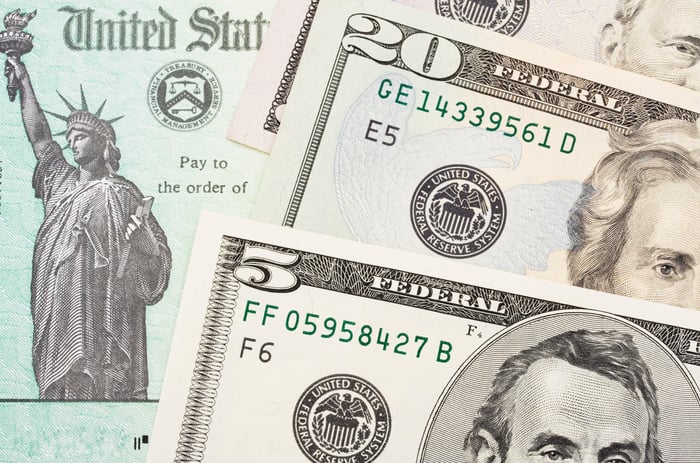For more than two months now, the coronavirus disease 2019 (COVID-19) has completely turned the American economy and labor market on its head. We've witnessed the end of the longest economic expansion in history in the U.S. (dating back 160 years) and seen more than 33 million Americans file for initial unemployment benefits in a seven-week stretch. By the time the full effects of the coronavirus are felt, a quarter of all Americans who want jobs may be out of work.
Knowing full well the sort of tumult that the shutdown of nonessential businesses would create, lawmakers on Capitol Hill passed and President Trump signed the Coronavirus Aid, Relief, and Economic Security (CARES) Act on March 27. At $2.2 trillion, it was the largest relief bill ever signed into law.

Image source: Getty Images.
Most Americans burned through their stimulus money in less than four weeks
The CARES Act wound up providing $500 billion to distressed industries, such as the airlines, set aside close to $350 billion for small business loans, supplied $100 billion to hospitals, and offered $260 billion to expand unemployment benefits through the end of July. This $260 billion is responsible for bumping up unemployment benefits by $600 a week for up to four months.
However, the perceived jewel of the CARES Act was the $300 billion directed at stimulus payouts to the American public and seniors. All told, more than 150 million Americans have qualified for an Economic Impact Payment, as these stimulus payouts are officially known, with maximum disbursements of $1,200 per individual or $2,400 per married couple filing jointly. Qualifying dependent children under the age of 17 can also add $500 per child to what a parent or household will receive. At last check, the Internal Revenue Service had divvied out almost $218 billion to nearly 130 million Americans.
While the stimulus money provided by the CARES Act was very much needed, it, in many instances, isn't doing nearly enough for most taxpayers or their families. A Money/Morning Consult survey of 2,200 people in late April showed that 46% had completely spent their Economic Impact Payment in two weeks, with 74% going through their payout in four weeks or less.
With the economy unlikely to snap back to where it was at the beginning of the year overnight, once businesses do fully reopen, additional stimulus measures almost certainly seem necessary.
The big question is, what should those additional stimulus measures look like?

Image source: Getty Images.
Introducing the HEROES Act
On Tuesday, the Democratic-led House of Representatives unveiled what they believe to be the answer.
The 1,815-page Health and Economic Recovery Omnibus Emergency Solutions Act, or HEROES Act, would come with a cost of around $3 trillion, surpassing the CARES Act, and direct money to a number of areas, including another round of direct stimulus payments to Americans and their families. While not a complete list, here's where some of this $3 trillion would be directed:
- $1 trillion would be provided to state, local, territorial, and tribal governments that need the funds to pay first-line responders and teachers.
- $200 billion would be set aside to establish the Heroes' Fund as a way of providing hazard pay to essential workers during the pandemic.
- $75 billion is provided for additional COVID-19 testing supplies and contact tracing measures.
- Extends unemployment benefit protections -- i.e., the extra $600 per week -- through January 2021.
- Allots $175 billion to aid families struggling to make their rent, mortgage, or utility payments.
But the eye-catcher of this $3 trillion proposal is the second round of stimulus payments.

Image source: Getty Images.
The HEROES Act calls for another $1,200 maximum payout for individuals, using the same eligibility pay scale under the CARES Act. Namely, single, married, and head-of-household filers with adjusted gross income of under $75,000, $150,000, and $112,500, respectively, would be eligible to receive the maximum payout.
However, there are some differences.
For one, qualifying dependents are now worth $1,200 extra for a parent or a household (with a three-dependent limit), instead of the $500 under the CARES Act. This means a married couple with three dependent children can qualify for a payment of up to $6,000.
Additionally, the language of the HEROES Act has been changed such that all dependents would qualify for this extra $1,200 for their parent or household, and not just children aged 16 and under. Under the CARES Act, senior dependents, as well as college-aged dependents, don't qualify for a payout, nor can their parent or household receive the $500 kicker.

Senate Majority Leader Mitch McConnell speaking to reporters, with Donald Trump looking on. Image source: Official White House Photo by Shealah Craighead.
The HEROES Act faces three major obstacles
Of course, introducing a game-changing bill and having it pass muster in Congress are two completely different things, more often than not. While well-intentioned, the HEROES Act faces three considerable obstacles moving forward.
First, there's little evidence that the Republican-led Senate or President Trump would go along with all (or any) of the measures introduced by the HEROES Act. President Trump has advocated in favor of a payroll tax reduction, while Senate Majority Leader Mitch McConnell (R-Ky.) has preferred a wait-and-see approach after passing the largest stimulus package in U.S. history. Certain aspects of the HEROES Act, such as providing $1 trillion to states, probably won't fly with many Republican lawmakers.
Secondly, the federal government has already spent around $3 trillion in various coronavirus-related bills. In addition to the CARES Act, Congress approved and the president signed a $484 billion stimulus package in April to aid small businesses. At some point, lawmakers are going to have to consider the long-term damage caused by enacting short-term stimulus measures.
Third and finally, it can rightly be argued that the HEROES Act still doesn't go far enough for families struggling with COVID-19 fallout. If approximately three-quarters of stimulus recipients went through their Economic Impact Payments in four weeks or less, a second one-time payout of the exact same amount will end in the same result. Without any assurances that business operations will return to normal anytime soon, the HEROES Act might be viewed as another Band-Aid for a gaping wound.
Expect talks to continue on a possible second round of direct stimulus payouts, but don't hold your breath on the HEROES Act being passed into law -- at least in its current form.






